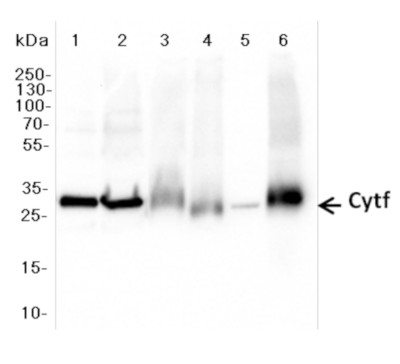| Can the exact same extraction and Western blot protocols be applied to detect a given target protein in samples from different species? As you will see in the example to the right, the quality and intensity of the PetA band in each analyzed species is different. The following samples were extracted: 1. Picea abies total proteins extract obtained from needles using 10% TCA/acetone, pellet was dissolved in 8M Urea, 40 mM Tris-HCl, pH 6.8, 0,1 mM EDTA, 1% SDS 2. Pinus sylvestris total proteins extract obtained from needles using 10% TCA/acetone, pellet was dissolved in 8M Urea, 40 mM Tris-HCl, pH 6.8, 0,1 mM EDTA, 1% SDS 3. Lupinus angustifolius thylakoid membranes 4. Solanum tuberosum thylakoid membranes 5. Synechococcus elongatus PCC7942 thylakoid membranes 6. Pisum sativum, thylakoid membranes Samples from conifers required another type of extraction compared to samples from other plant species. In the case of cyanobacterial sample, a higher protein load per well and longer incubation time of the primary antibody is required. This result clearly shows that extraction and Western blot protocols have to be adjusted depending on sample type and source. If you have any questions or require Agrisera technical assistance, you are welcome to contact us. We have over 20 years of experience in Western blot technique. |  Anti-PetA antibodies (AS20 4377) Western blot result courtesy of Dr. Elena Pojidaeva Laboratory of Plant Gene Expression Timiryazev Institute of Plant Physiology RAS 127276 Moscow, Russia. More details of the applied Western blot protocol can be found here. Agrisera Western blot protocol example can be found here. Western blot video tutorials - watch here. Agrisera Western Blot Trouble Shooting Brochure, request here. |
Latest
Is wild type a wild type?2025-12-29 Why an antibody may detect tagged protein but not endogenous one and in some cases endogenous protein but not its tagged version?
2025-10-30 Calclulated and aparent molecular weight of detected protein is different, why?
2025-10-09 How to chose right loading control for Western blot?
2025-10-06 Is an antibody going to work in a technique I am planning to use it in?
2025-09-30 Antibody reactivity to recombinant protein,does not validate antibody specificity in endogenous sample
2025-08-20 Can aggregated antibody be still used?
2025-08-15 Blot Once, Probe Twice - when such approach can be beneficial?
2025-07-31 Why should glycerol not be added, to stabilize antibodies in serum?
2025-06-27 Can methanol in transfer buffer be replaced by a less toxic alternative?
2025-05-12
Archive
- December - 2025
- October - 2025
- September - 2025
- August - 2025
- July - 2025
- June - 2025
- May - 2025
- April - 2025
- March - 2025
- February - 2025
- January - 2025
- December - 2024
- November - 2024
- September - 2024
- July - 2024
- June - 2024
- May - 2024
- March - 2024
- February - 2024
- December - 2023
- November - 2023
- September - 2023
- July - 2023
- May - 2023
- March - 2023
- January - 2023
- December - 2022
- November - 2022
- October - 2022
- September - 2022
- August - 2022
- June - 2022
- May - 2022
- March - 2022
- February - 2022
- January - 2022
- November - 2021
- October - 2021
- August - 2021
- June - 2021
- May - 2021
- April - 2021
- March - 2021
- February - 2021
- January - 2021
- December - 2020
- November - 2020
- October - 2020
- September - 2020
- August - 2020
- July - 2020
- June - 2020
- May - 2020
- April - 2020
- March - 2020
- January - 2020
- November - 2019
- October - 2019
- March - 2019
- April - 2017
- February - 2017
- May - 2016
- February - 2014
- September - 2013
- December - 2010
